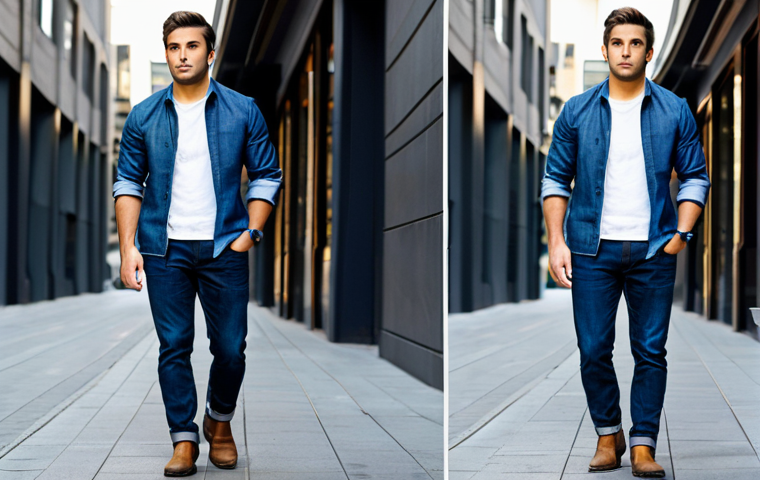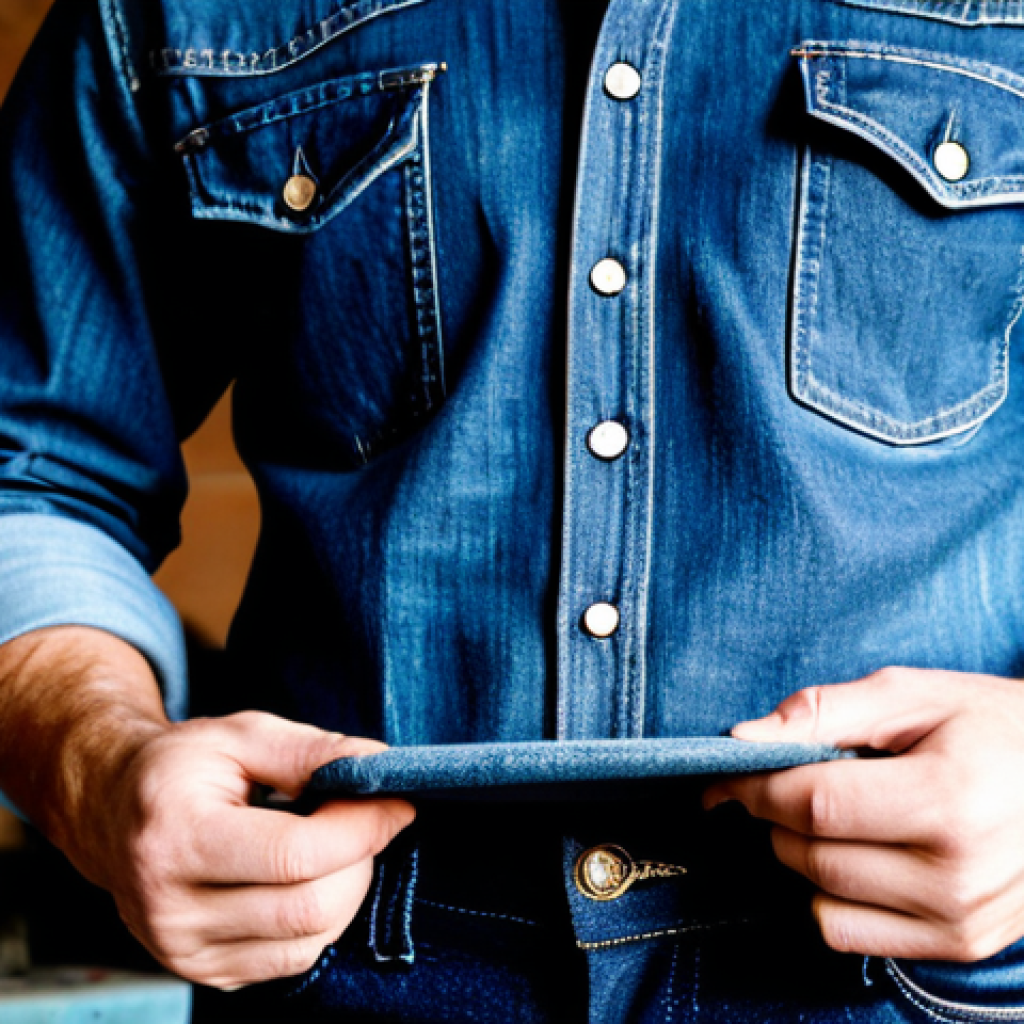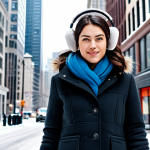Okay, here is the intro as you requested:For a man, finding the perfect pair of jeans can feel like an epic quest. We’re talking about comfort, style, and versatility all rolled into one.
And when it comes to a wardrobe staple, the straight-fit jean reigns supreme. It’s the kind of denim that can take you from a casual weekend brunch to a laid-back office setting without missing a beat.
Plus, with trends leaning towards timeless pieces, a good pair of straight-fit jeans is an investment that pays off season after season. Personally, I’ve found that the right pair can boost my confidence and make me feel put-together no matter what the day throws my way.
So, how do you navigate the world of washes, weights, and widths to find your denim soulmate? Let’s dive deeper and get you sorted. Let’s get the facts straight!
Okay, let’s get started.
Decoding Denim: Understanding Fabric Weight and Weaves

1. The Nitty-Gritty of Ounces: Lightweight vs. Heavyweight
When you’re shopping for straight-fit jeans, the weight of the denim is a game-changer. Lightweight denim (think under 12 oz) is breathable and perfect for warmer climates or summer days. It drapes nicely and feels almost like a second skin. On the flip side, heavyweight denim (14 oz and up) is where you get that rugged, durable feel. It takes a bit longer to break in, but the payoff is jeans that mold to your body over time and last for years. I remember snagging a pair of 14 oz raw denim jeans a few years back. The first few weeks were rough – they were stiff and unforgiving. But now? They’re my go-to pair, with fades and creases that tell my story. It’s like they’re not just jeans; they’re a time capsule of my daily adventures.
2. Twill Talk: Exploring Different Weaves
Beyond the weight, the weave of the denim affects its texture and appearance. The most common is the twill weave, characterized by diagonal ribs on the fabric’s surface. But within twill, you’ve got variations like right-hand twill (the ribs run from the lower left to the upper right) and left-hand twill (the opposite direction). Right-hand twill is more common and tends to be a bit stiffer, while left-hand twill often results in a softer feel. Then there’s broken twill, which is exactly what it sounds like: the twill pattern is intentionally disrupted, creating a unique texture and preventing the fabric from twisting. I once bought a pair of jeans made from broken twill without realizing it. The subtle texture added so much character, and I constantly got compliments on them. It just goes to show that the weave can make all the difference.
Finding Your Perfect Fit: Waist, Rise, and Leg Opening
1. Waist Size Wisdom: Measuring for Comfort
Let’s face it: vanity sizing is real. What you think your waist size is might not be what the jeans label says. Your best bet is to grab a flexible measuring tape and measure your natural waistline – that’s the narrowest part of your torso, usually just above your belly button. Don’t suck in your stomach! You want a comfortable measurement. Then, compare that measurement to the brand’s size chart. Every brand fits differently, so this step is crucial. I’ve been burned before by assuming I knew my size. I ended up with jeans that were so tight, I could barely breathe. Now, I always double-check the size chart. It’s a lifesaver.
2. Rise Above: Understanding Front and Back Rise
The rise of your jeans is the distance from the crotch seam to the top of the waistband. A higher rise sits closer to your natural waist, while a lower rise sits lower on your hips. Straight-fit jeans typically have a mid-rise, which is a happy medium for most body types. But personal preference plays a big role. A higher rise can be more comfortable for some, especially when sitting for long periods. A lower rise can feel more modern and stylish. The back rise is also important – it determines how well the jeans cover your backside. Nobody wants to deal with plumber’s crack, so make sure the back rise is adequate! I remember trying on a pair of low-rise jeans in my younger days. Let’s just say I spent the entire day pulling them up. Lesson learned: rise matters.
3. Leg Opening Lowdown: Straight vs. Tapered
The leg opening is the width of the jeans at the hem. Straight-fit jeans should have a relatively consistent width from the thigh to the ankle, creating a straight line. Some straight-fit styles might have a slight taper towards the ankle, but it shouldn’t be too dramatic. If the leg opening is too wide, the jeans can look baggy. If it’s too narrow, they can look like skinny jeans. The key is to find a leg opening that balances your proportions. A good rule of thumb is to measure the width of your shoes and make sure the leg opening is slightly wider. That way, the jeans will drape nicely over your shoes without bunching up. I’ve seen guys rocking straight-fit jeans with a leg opening that’s way too small, and it just throws off the whole look. It’s all about balance.
The Wash Effect: From Raw to Rinsed
1. Raw Power: The Beauty of Unwashed Denim
Raw denim, also known as dry denim, is denim that hasn’t been washed or treated after being dyed. It’s a blank canvas waiting to be personalized by your wear patterns. Raw denim is typically stiff and dark indigo in color, and it fades beautifully over time, creating unique creases and fades that reflect your lifestyle. Breaking in raw denim takes dedication – it can be uncomfortable at first, and you might need to avoid washing them for several months to develop those coveted fades. But the result is a pair of jeans that’s truly one-of-a-kind. I’ve got a friend who’s obsessed with raw denim. He meticulously tracks his wear patterns and only washes his jeans when absolutely necessary. It’s a whole art form.
2. Rinsed and Ready: Subtly Softened Denim
Rinsed denim has been lightly washed to soften the fabric and remove some of the stiffness of raw denim. It’s a great option if you want a more comfortable pair of jeans right out of the gate. Rinsed denim typically retains a deep indigo color but lacks the high contrast fades of raw denim. It’s a good choice for guys who want a classic look without the commitment of raw denim. I often recommend rinsed denim to guys who are new to the world of quality jeans. It’s a good entry point without the pain and suffering of breaking in raw denim.
3. Stone-Washed Wonders: Achieving That Vintage Vibe
Stone-washed denim is washed with pumice stones to create a faded, worn-in look. The stones abrade the fabric, creating a soft texture and a vintage vibe. Stone-washed jeans can range from lightly faded to heavily distressed, depending on the intensity of the washing process. Keep in mind that stone washing can weaken the fabric over time, so stone-washed jeans might not be as durable as raw or rinsed denim. However, they can be a stylish choice if you’re going for a relaxed, lived-in look. I’ve got a stone-washed denim jacket that I absolutely love. It’s got that perfect worn-in feel, like I’ve had it for decades.
Color Considerations: Beyond Basic Blue
1. Indigo Insights: The Classic Denim Hue
Indigo is the quintessential denim color, ranging from deep, dark blues to lighter, more faded shades. Indigo dye is unique because it doesn’t fully penetrate the cotton fibers, which allows for fading and creasing over time. A classic pair of indigo straight-fit jeans is a wardrobe staple that can be dressed up or down. The key is to find an indigo wash that complements your skin tone and personal style. Darker indigo washes are more formal and versatile, while lighter washes are more casual and relaxed. I’ve found that a mid-indigo wash is the sweet spot for me – it’s dark enough to look polished but light enough to be comfortable for everyday wear.
2. Black is Back: Sleek and Sophisticated Denim
Black denim is a stylish alternative to indigo, offering a sleek and sophisticated look. Black straight-fit jeans can be dressed up with a blazer and dress shoes or dressed down with a t-shirt and sneakers. Black denim is also a good choice for guys who want to create a slimmer silhouette. However, black denim can fade over time, so it’s important to choose a high-quality pair that’s dyed with a fade-resistant dye. I’ve got a pair of black straight-fit jeans that I wear to concerts and nights out. They’re a bit edgier than indigo jeans and always make me feel confident.
3. Gray Matters: Neutral and Versatile Denim
Gray denim is a neutral alternative that pairs well with a variety of colors. Gray straight-fit jeans can be dressed up or down, making them a versatile addition to your wardrobe. Gray denim comes in a range of shades, from light heather gray to dark charcoal gray. Lighter gray washes are more casual, while darker gray washes are more formal. I’ve seen guys rock gray jeans with everything from bright pops of color to monochromatic outfits. It’s a great way to add some visual interest without being too flashy.
Details That Define: Rivets, Stitching, and Hardware
1. Rivet Recognition: Reinforcing the Classics
Rivets are those small metal fasteners that reinforce stress points on jeans, like the corners of pockets and the base of the fly. Rivets were originally added to workwear jeans to prevent them from tearing under heavy use. Today, they’re both functional and decorative. Rivets can be made from a variety of metals, including copper, brass, and steel. The color and finish of the rivets can add to the overall look of the jeans. I appreciate the subtle details like rivets – they show that the manufacturer paid attention to quality and durability.
2. Stitching Stories: A Visual Language
The stitching on jeans is more than just a way to hold the fabric together – it’s also a design element. The color, thickness, and pattern of the stitching can add visual interest and character to the jeans. Some brands use contrasting stitching to highlight the seams and pockets, while others use tonal stitching for a more subtle look. The stitching on the back pockets is often a signature design element for many brands. I always check out the stitching on a pair of jeans before I buy them. It’s a good indicator of the overall quality and attention to detail.
3. Buttoned Up: The Fly Closure Factor
The fly closure on jeans can be either a button fly or a zipper fly. Button flies are more traditional and durable, while zipper flies are more convenient. Button flies require a bit more effort to fasten, but they’re less likely to break than zippers. Zipper flies are quick and easy to use, but the zipper can sometimes fail. The choice between a button fly and a zipper fly is largely a matter of personal preference. I personally prefer button flies because I like the classic look and feel. But I know plenty of guys who swear by zipper flies for their convenience.
Styling Straight-Fit Jeans: Versatility in Action
1. Casual Cool: T-Shirts and Sneakers
For a casual, everyday look, pair your straight-fit jeans with a t-shirt and sneakers. A simple white t-shirt is always a good choice, but you can also experiment with different colors, patterns, and graphics. For sneakers, go for classic styles like Converse Chuck Taylors, Adidas Stan Smiths, or Vans Old Skools. This is a comfortable and effortless outfit that’s perfect for running errands, grabbing coffee, or hanging out with friends. I practically live in this outfit on weekends. It’s the ultimate in casual cool.
2. Smart Casual: Button-Downs and Boots
To dress up your straight-fit jeans, pair them with a button-down shirt and boots. A crisp white button-down is a versatile option that can be worn with a variety of washes and colors of denim. For boots, go for classic styles like Chelsea boots, chukka boots, or work boots. This outfit is perfect for a casual office environment, a dinner date, or a night out on the town. I often wear this outfit when I want to look put-together without being too formal.
3. Layering Lessons: Jackets and Outerwear
Layering is a great way to add visual interest and warmth to your outfit. Pair your straight-fit jeans with a jacket or other outerwear. A denim jacket is a classic choice that complements denim jeans, but you can also experiment with other styles like a leather jacket, a bomber jacket, or a field jacket. For colder weather, add a sweater or a cardigan under your jacket. This outfit is perfect for transitioning between seasons. I love layering because it allows me to express my personal style and stay comfortable in any weather.
Maintaining Your Denim: Care and Longevity
1. Washing Wisdom: When and How to Clean
Washing your jeans too often can cause them to fade and wear out more quickly. The general rule of thumb is to wash your jeans only when they’re visibly dirty or start to smell. When you do wash your jeans, turn them inside out and wash them in cold water on a gentle cycle. Use a mild detergent that’s designed for denim. Avoid using bleach or fabric softener, as these can damage the fabric. Hang your jeans to dry or tumble dry them on low heat. I’ve heard stories of guys who never wash their jeans, but that’s a bit extreme for me. I usually wash mine every few months, or when they get particularly dirty.
2. Repair and Reinforce: Extending the Life of Your Jeans
If your jeans develop a tear or hole, don’t throw them away! You can repair them with a patch or by sewing them up. Reinforce stress points, like the crotch and the knees, with extra stitching. You can also take your jeans to a tailor for professional repairs. Repairing your jeans is a great way to extend their lifespan and save money. Plus, it adds character and personality to your jeans. I’ve got a pair of jeans that I’ve patched up several times. They’re like a patchwork quilt of my life.
3. Storage Solutions: Keeping Your Denim Fresh
Store your jeans in a cool, dry place away from direct sunlight. Fold them neatly or hang them on hangers. Avoid storing them in plastic bags, as this can trap moisture and cause mildew. If you’re storing your jeans for a long period of time, consider adding a cedar block or a sachet of lavender to keep them fresh. Proper storage is key to maintaining the quality and longevity of your jeans. I’ve got a whole section of my closet dedicated to my jeans collection. It’s a bit obsessive, but I take my denim seriously.
| Feature | Lightweight Denim (Under 12 oz) | Heavyweight Denim (14 oz and Up) |
|---|---|---|
| Comfort | Breathable, good for warm weather | Stiffer initially, molds to body over time |
| Durability | Less durable | Highly durable |
| Fading | Fades more quickly | Fades slowly, high contrast fades |
| Best For | Summer, casual wear | Year-round, rugged wear |
In Conclusion
Finding the perfect pair of straight-fit jeans is a journey, not a destination. It’s about understanding the nuances of denim weight, weave, and wash, and how these elements interact with your body type and personal style. Don’t be afraid to experiment and try on different styles until you find the jeans that make you feel confident and comfortable. Remember, the best jeans are the ones that tell your story.
Happy denim hunting!
Useful Tips to Know
1.
Denim Stretch Test: Gently stretch the denim fabric. If it snaps back quickly, it’s a good sign of quality and resilience.
2.
Pocket Placement: The placement and size of the back pockets can dramatically affect how your backside looks. Higher pockets can give a lifted appearance.
3.
Coin Pocket Clues: That tiny pocket inside your front right pocket? It was originally designed for cowboys to hold their pocket watches. Now you know!
4.
Cuffing Considerations: Cuffing your jeans can alter the overall look. A wider cuff is more casual, while a narrow cuff is slightly more polished.
5.
Belt Loop Breakdown: Jeans with more belt loops tend to fit better and hold their shape longer, especially with heavier denim.
Key Takeaways
Weight Matters: Lightweight for summer, heavyweight for durability and unique fading.
Fit is Paramount: Accurate waist measurement and understanding rise are crucial.
Wash Wisdom: Raw denim offers personalization, rinsed denim provides comfort.
Details Define: Rivets, stitching, and fly closures are indicators of quality.
Styling Versatility: Straight-fit jeans can be dressed up or down for any occasion.
Frequently Asked Questions (FAQ) 📖
Q: What exactly is a “straight-fit” jean? I’ve seen so many different styles out there!
A: Good question! Basically, straight-fit jeans are cut with a consistent width from the hip down to the leg opening. Unlike slim-fit jeans that taper towards the ankle or bootcut jeans that flare out, straight-fit jeans maintain a fairly uniform width.
Imagine a classic, clean line – that’s the straight fit. I remember when I first started shopping for jeans, I was so confused by all the different terms.
This one’s pretty easy to spot once you know what to look for!
Q: I’m a bigger guy.
A: re straight-fit jeans going to look good on me? I don’t want to look like I’m wearing drainpipes! A2: Absolutely!
That’s the beauty of straight-fit jeans. They’re incredibly versatile and often more flattering for a variety of body types, especially if you’re built more robustly.
Slim-fit jeans can sometimes accentuate larger thighs or calves, but straight-fit jeans offer a more balanced silhouette. Just make sure you get the right size in the waist and seat.
Too tight, and they’ll be uncomfortable. Too loose, and they’ll look sloppy. Finding that sweet spot is key!
Trust me, I’ve been there. I used to squeeze myself into skinnier styles thinking it was “trendy,” but a well-fitting pair of straight-fit jeans makes me feel way more comfortable and confident.
Q: Okay, I’m convinced. But what shoes should I wear with straight-fit jeans? I don’t want to commit a major fashion faux pas.
A: You’ve got options! Straight-fit jeans are super adaptable when it comes to footwear. For a casual look, think sneakers like Converse Chuck Taylors, Vans, or even a pair of crisp white trainers.
Boots work great too – Chelsea boots, work boots, even desert boots can look fantastic. For a slightly dressier vibe, consider loafers or even a pair of well-maintained dress shoes, like brogues.
The key is to make sure the length of your jeans works with the shoes you choose. You don’t want them bunching up too much at the ankle or dragging on the ground.
A slight break, where the hem just barely touches the top of your shoe, is generally considered a good look. I personally love pairing my dark wash straight-fit jeans with brown leather Chelsea boots for a night out.
It’s a classic combo that always works.
📚 References
Wikipedia Encyclopedia
구글 검색 결과
구글 검색 결과
구글 검색 결과
구글 검색 결과
구글 검색 결과






